Analysis of Intelligent Building Technology: Chiller Selection
VerifiedAdded on 2020/04/15
|32
|6415
|452
Report
AI Summary
This report provides a comprehensive analysis of intelligent building technology, with a specific focus on chiller systems. It begins with an introduction to intelligent buildings, outlining their evolution and the integration of smart systems to enhance safety, comfort, and efficiency. The report then delves into a literature review, discussing chiller selection criteria, including building load, chiller control characteristics, and velocity limits. Different types of chilled water systems, such as variable primary flow and variable secondary flow, are compared, along with their advantages and disadvantages. The methodology section explores chiller maintenance. The analysis and discussion section examines the energy effects and carbon footprint of these systems. The report concludes by summarizing the key findings and referencing relevant sources. The study includes figures and tables to illustrate key concepts, such as chiller selection criteria and questionnaires.
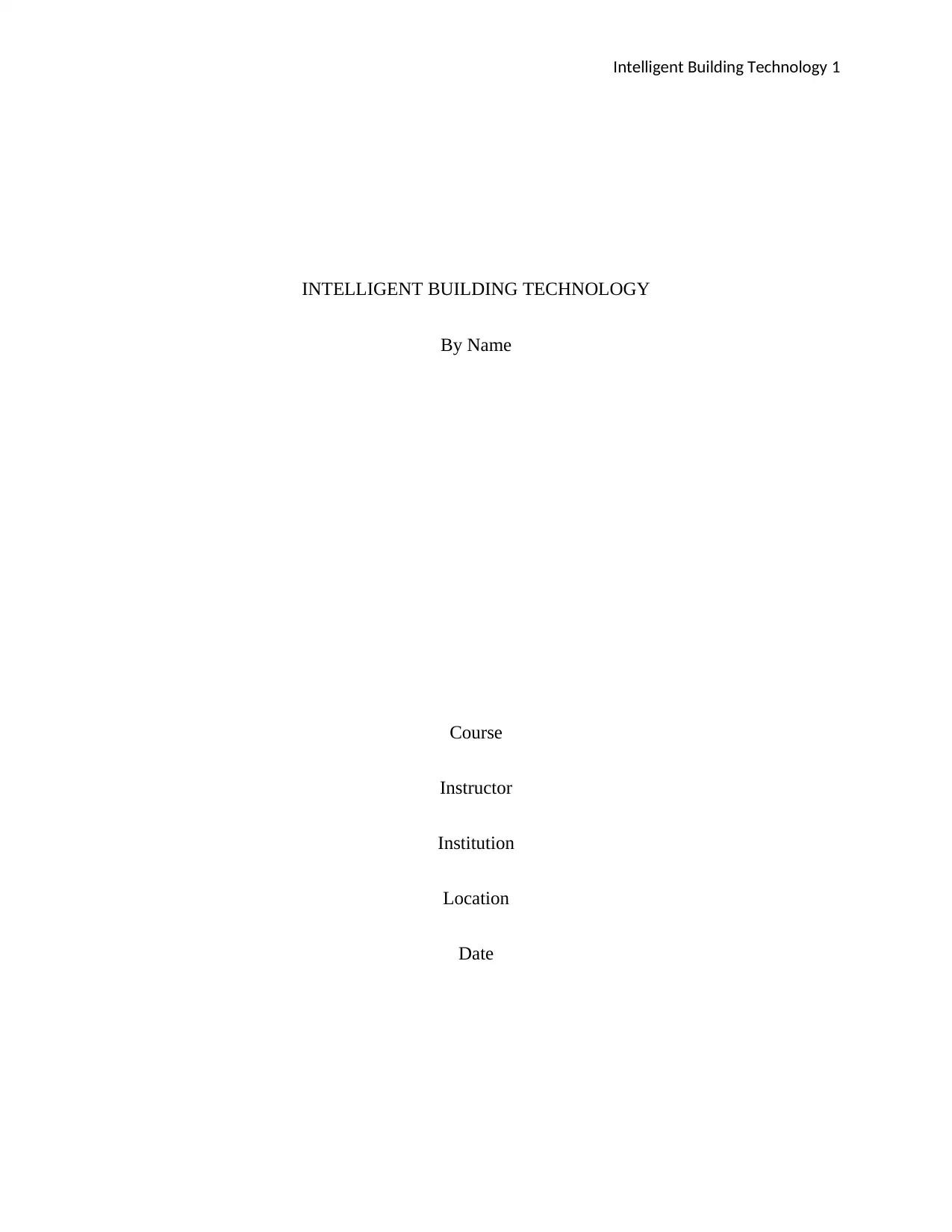
Intelligent Building Technology 1
INTELLIGENT BUILDING TECHNOLOGY
By Name
Course
Instructor
Institution
Location
Date
INTELLIGENT BUILDING TECHNOLOGY
By Name
Course
Instructor
Institution
Location
Date
Paraphrase This Document
Need a fresh take? Get an instant paraphrase of this document with our AI Paraphraser
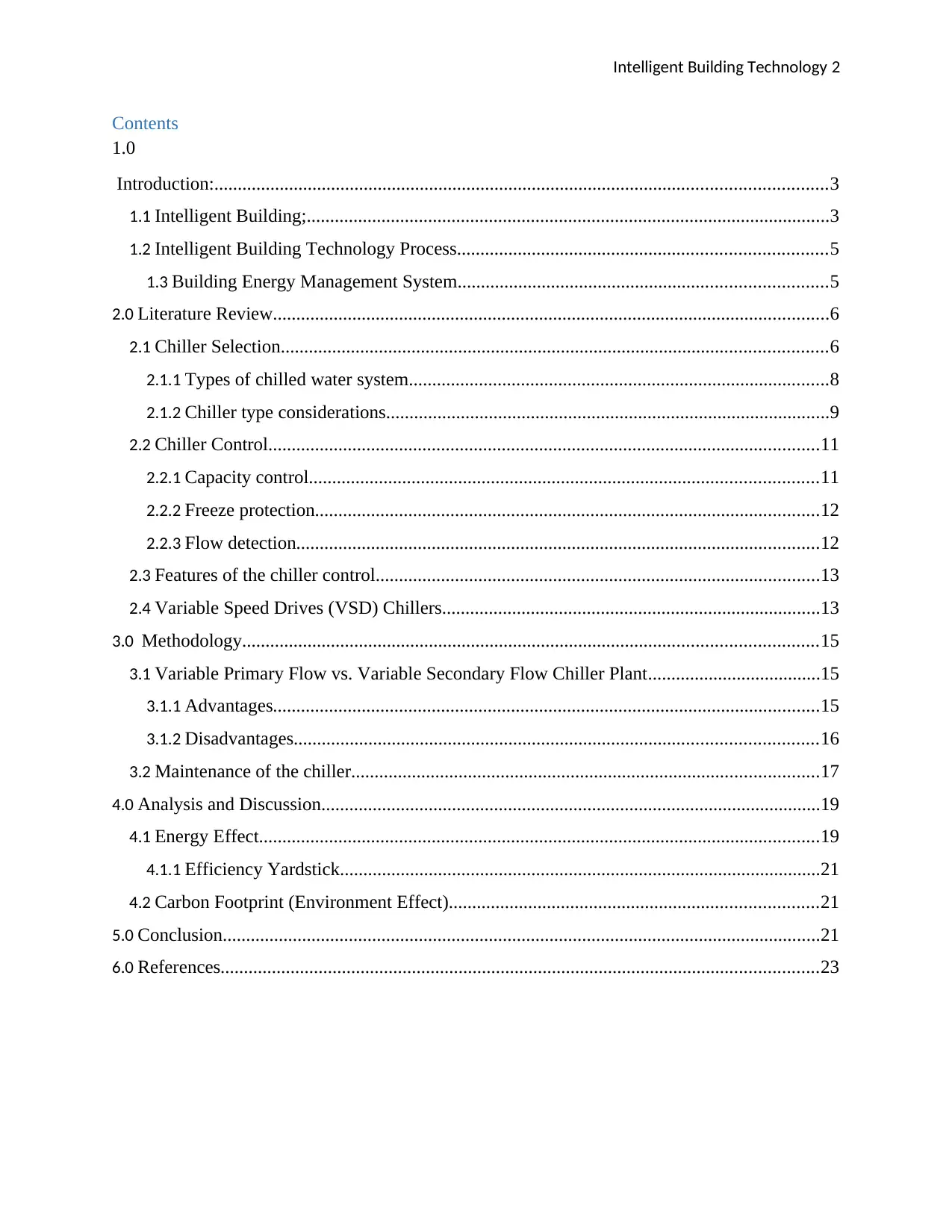
Intelligent Building Technology 2
Contents
1.0
Introduction:...................................................................................................................................3
1.1 Intelligent Building;................................................................................................................3
1.2 Intelligent Building Technology Process...............................................................................5
1.3 Building Energy Management System...............................................................................5
2.0 Literature Review.......................................................................................................................6
2.1 Chiller Selection.....................................................................................................................6
2.1.1 Types of chilled water system..........................................................................................8
2.1.2 Chiller type considerations...............................................................................................9
2.2 Chiller Control......................................................................................................................11
2.2.1 Capacity control.............................................................................................................11
2.2.2 Freeze protection............................................................................................................12
2.2.3 Flow detection................................................................................................................12
2.3 Features of the chiller control...............................................................................................13
2.4 Variable Speed Drives (VSD) Chillers.................................................................................13
3.0 Methodology...........................................................................................................................15
3.1 Variable Primary Flow vs. Variable Secondary Flow Chiller Plant.....................................15
3.1.1 Advantages.....................................................................................................................15
3.1.2 Disadvantages................................................................................................................16
3.2 Maintenance of the chiller....................................................................................................17
4.0 Analysis and Discussion...........................................................................................................19
4.1 Energy Effect........................................................................................................................19
4.1.1 Efficiency Yardstick.......................................................................................................21
4.2 Carbon Footprint (Environment Effect)...............................................................................21
5.0 Conclusion................................................................................................................................21
6.0 References................................................................................................................................23
Contents
1.0
Introduction:...................................................................................................................................3
1.1 Intelligent Building;................................................................................................................3
1.2 Intelligent Building Technology Process...............................................................................5
1.3 Building Energy Management System...............................................................................5
2.0 Literature Review.......................................................................................................................6
2.1 Chiller Selection.....................................................................................................................6
2.1.1 Types of chilled water system..........................................................................................8
2.1.2 Chiller type considerations...............................................................................................9
2.2 Chiller Control......................................................................................................................11
2.2.1 Capacity control.............................................................................................................11
2.2.2 Freeze protection............................................................................................................12
2.2.3 Flow detection................................................................................................................12
2.3 Features of the chiller control...............................................................................................13
2.4 Variable Speed Drives (VSD) Chillers.................................................................................13
3.0 Methodology...........................................................................................................................15
3.1 Variable Primary Flow vs. Variable Secondary Flow Chiller Plant.....................................15
3.1.1 Advantages.....................................................................................................................15
3.1.2 Disadvantages................................................................................................................16
3.2 Maintenance of the chiller....................................................................................................17
4.0 Analysis and Discussion...........................................................................................................19
4.1 Energy Effect........................................................................................................................19
4.1.1 Efficiency Yardstick.......................................................................................................21
4.2 Carbon Footprint (Environment Effect)...............................................................................21
5.0 Conclusion................................................................................................................................21
6.0 References................................................................................................................................23
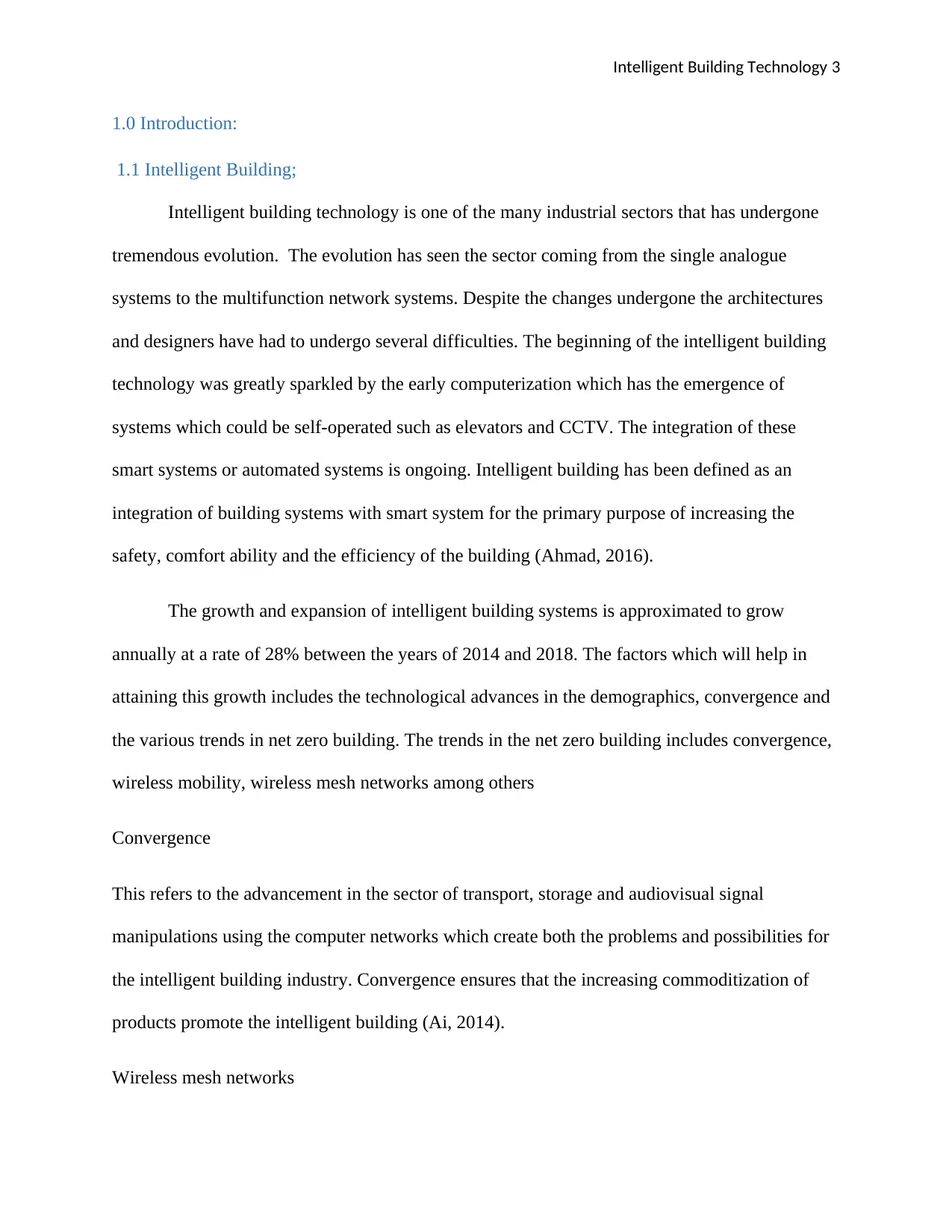
Intelligent Building Technology 3
1.0 Introduction:
1.1 Intelligent Building;
Intelligent building technology is one of the many industrial sectors that has undergone
tremendous evolution. The evolution has seen the sector coming from the single analogue
systems to the multifunction network systems. Despite the changes undergone the architectures
and designers have had to undergo several difficulties. The beginning of the intelligent building
technology was greatly sparkled by the early computerization which has the emergence of
systems which could be self-operated such as elevators and CCTV. The integration of these
smart systems or automated systems is ongoing. Intelligent building has been defined as an
integration of building systems with smart system for the primary purpose of increasing the
safety, comfort ability and the efficiency of the building (Ahmad, 2016).
The growth and expansion of intelligent building systems is approximated to grow
annually at a rate of 28% between the years of 2014 and 2018. The factors which will help in
attaining this growth includes the technological advances in the demographics, convergence and
the various trends in net zero building. The trends in the net zero building includes convergence,
wireless mobility, wireless mesh networks among others
Convergence
This refers to the advancement in the sector of transport, storage and audiovisual signal
manipulations using the computer networks which create both the problems and possibilities for
the intelligent building industry. Convergence ensures that the increasing commoditization of
products promote the intelligent building (Ai, 2014).
Wireless mesh networks
1.0 Introduction:
1.1 Intelligent Building;
Intelligent building technology is one of the many industrial sectors that has undergone
tremendous evolution. The evolution has seen the sector coming from the single analogue
systems to the multifunction network systems. Despite the changes undergone the architectures
and designers have had to undergo several difficulties. The beginning of the intelligent building
technology was greatly sparkled by the early computerization which has the emergence of
systems which could be self-operated such as elevators and CCTV. The integration of these
smart systems or automated systems is ongoing. Intelligent building has been defined as an
integration of building systems with smart system for the primary purpose of increasing the
safety, comfort ability and the efficiency of the building (Ahmad, 2016).
The growth and expansion of intelligent building systems is approximated to grow
annually at a rate of 28% between the years of 2014 and 2018. The factors which will help in
attaining this growth includes the technological advances in the demographics, convergence and
the various trends in net zero building. The trends in the net zero building includes convergence,
wireless mobility, wireless mesh networks among others
Convergence
This refers to the advancement in the sector of transport, storage and audiovisual signal
manipulations using the computer networks which create both the problems and possibilities for
the intelligent building industry. Convergence ensures that the increasing commoditization of
products promote the intelligent building (Ai, 2014).
Wireless mesh networks
⊘ This is a preview!⊘
Do you want full access?
Subscribe today to unlock all pages.

Trusted by 1+ million students worldwide
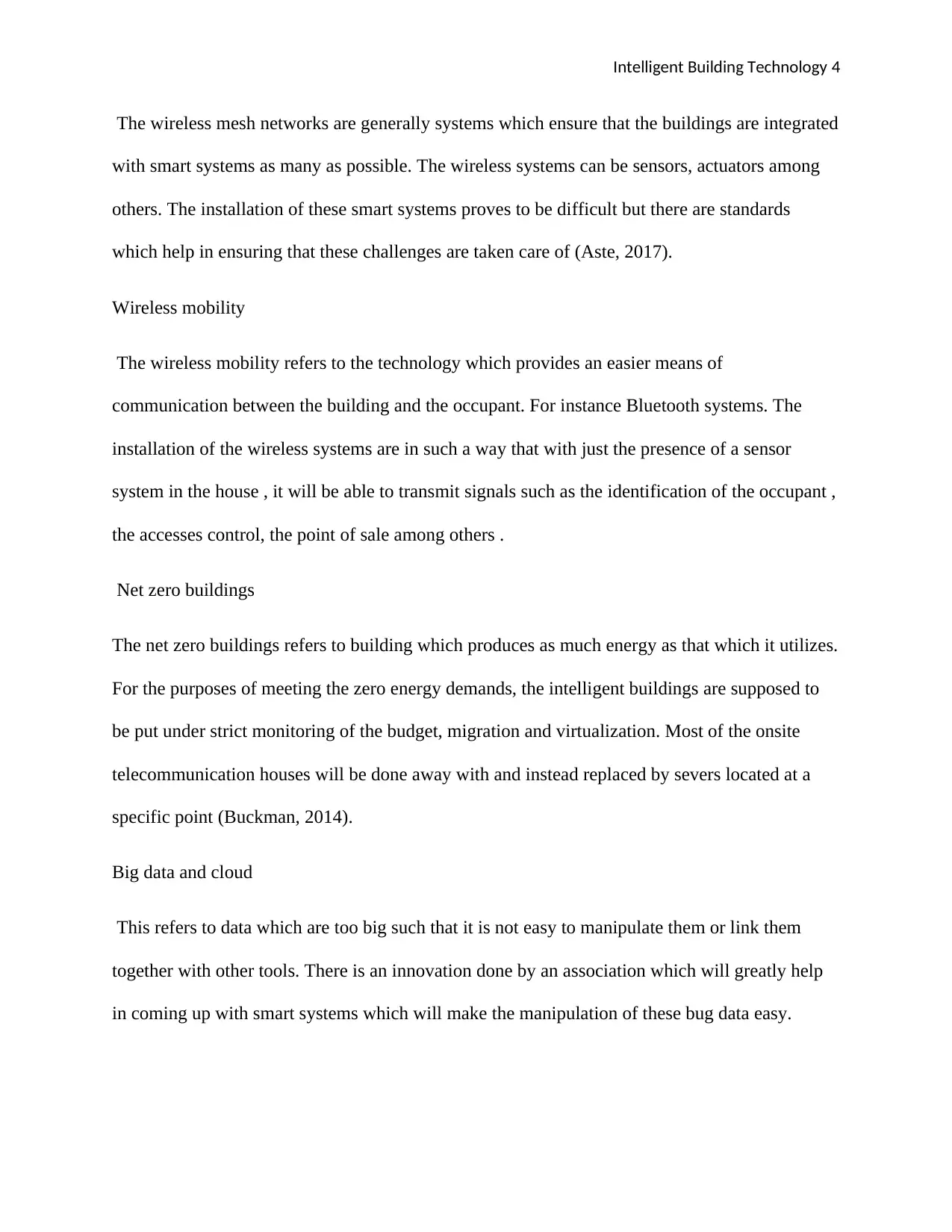
Intelligent Building Technology 4
The wireless mesh networks are generally systems which ensure that the buildings are integrated
with smart systems as many as possible. The wireless systems can be sensors, actuators among
others. The installation of these smart systems proves to be difficult but there are standards
which help in ensuring that these challenges are taken care of (Aste, 2017).
Wireless mobility
The wireless mobility refers to the technology which provides an easier means of
communication between the building and the occupant. For instance Bluetooth systems. The
installation of the wireless systems are in such a way that with just the presence of a sensor
system in the house , it will be able to transmit signals such as the identification of the occupant ,
the accesses control, the point of sale among others .
Net zero buildings
The net zero buildings refers to building which produces as much energy as that which it utilizes.
For the purposes of meeting the zero energy demands, the intelligent buildings are supposed to
be put under strict monitoring of the budget, migration and virtualization. Most of the onsite
telecommunication houses will be done away with and instead replaced by severs located at a
specific point (Buckman, 2014).
Big data and cloud
This refers to data which are too big such that it is not easy to manipulate them or link them
together with other tools. There is an innovation done by an association which will greatly help
in coming up with smart systems which will make the manipulation of these bug data easy.
The wireless mesh networks are generally systems which ensure that the buildings are integrated
with smart systems as many as possible. The wireless systems can be sensors, actuators among
others. The installation of these smart systems proves to be difficult but there are standards
which help in ensuring that these challenges are taken care of (Aste, 2017).
Wireless mobility
The wireless mobility refers to the technology which provides an easier means of
communication between the building and the occupant. For instance Bluetooth systems. The
installation of the wireless systems are in such a way that with just the presence of a sensor
system in the house , it will be able to transmit signals such as the identification of the occupant ,
the accesses control, the point of sale among others .
Net zero buildings
The net zero buildings refers to building which produces as much energy as that which it utilizes.
For the purposes of meeting the zero energy demands, the intelligent buildings are supposed to
be put under strict monitoring of the budget, migration and virtualization. Most of the onsite
telecommunication houses will be done away with and instead replaced by severs located at a
specific point (Buckman, 2014).
Big data and cloud
This refers to data which are too big such that it is not easy to manipulate them or link them
together with other tools. There is an innovation done by an association which will greatly help
in coming up with smart systems which will make the manipulation of these bug data easy.
Paraphrase This Document
Need a fresh take? Get an instant paraphrase of this document with our AI Paraphraser
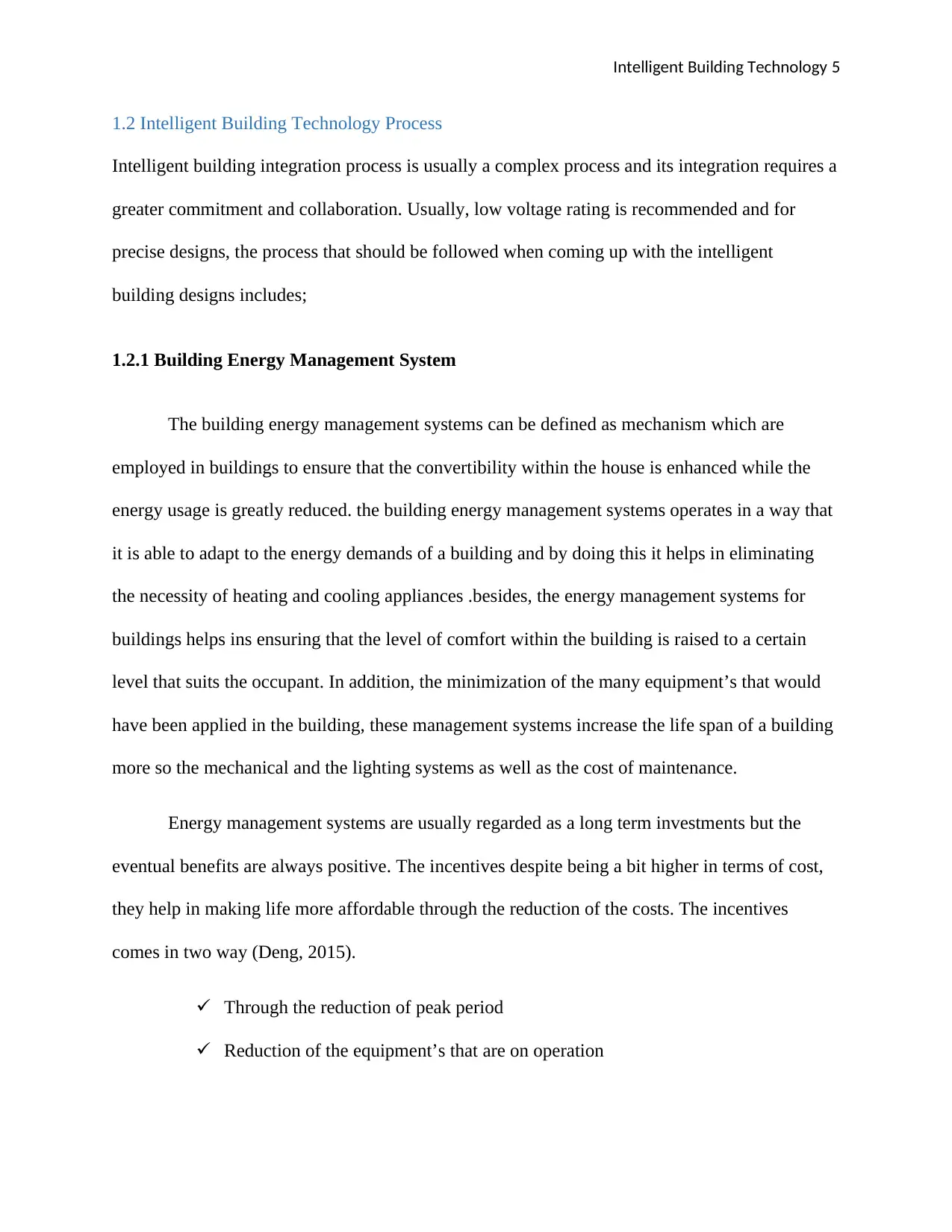
Intelligent Building Technology 5
1.2 Intelligent Building Technology Process
Intelligent building integration process is usually a complex process and its integration requires a
greater commitment and collaboration. Usually, low voltage rating is recommended and for
precise designs, the process that should be followed when coming up with the intelligent
building designs includes;
1.2.1 Building Energy Management System
The building energy management systems can be defined as mechanism which are
employed in buildings to ensure that the convertibility within the house is enhanced while the
energy usage is greatly reduced. the building energy management systems operates in a way that
it is able to adapt to the energy demands of a building and by doing this it helps in eliminating
the necessity of heating and cooling appliances .besides, the energy management systems for
buildings helps ins ensuring that the level of comfort within the building is raised to a certain
level that suits the occupant. In addition, the minimization of the many equipment’s that would
have been applied in the building, these management systems increase the life span of a building
more so the mechanical and the lighting systems as well as the cost of maintenance.
Energy management systems are usually regarded as a long term investments but the
eventual benefits are always positive. The incentives despite being a bit higher in terms of cost,
they help in making life more affordable through the reduction of the costs. The incentives
comes in two way (Deng, 2015).
Through the reduction of peak period
Reduction of the equipment’s that are on operation
1.2 Intelligent Building Technology Process
Intelligent building integration process is usually a complex process and its integration requires a
greater commitment and collaboration. Usually, low voltage rating is recommended and for
precise designs, the process that should be followed when coming up with the intelligent
building designs includes;
1.2.1 Building Energy Management System
The building energy management systems can be defined as mechanism which are
employed in buildings to ensure that the convertibility within the house is enhanced while the
energy usage is greatly reduced. the building energy management systems operates in a way that
it is able to adapt to the energy demands of a building and by doing this it helps in eliminating
the necessity of heating and cooling appliances .besides, the energy management systems for
buildings helps ins ensuring that the level of comfort within the building is raised to a certain
level that suits the occupant. In addition, the minimization of the many equipment’s that would
have been applied in the building, these management systems increase the life span of a building
more so the mechanical and the lighting systems as well as the cost of maintenance.
Energy management systems are usually regarded as a long term investments but the
eventual benefits are always positive. The incentives despite being a bit higher in terms of cost,
they help in making life more affordable through the reduction of the costs. The incentives
comes in two way (Deng, 2015).
Through the reduction of peak period
Reduction of the equipment’s that are on operation
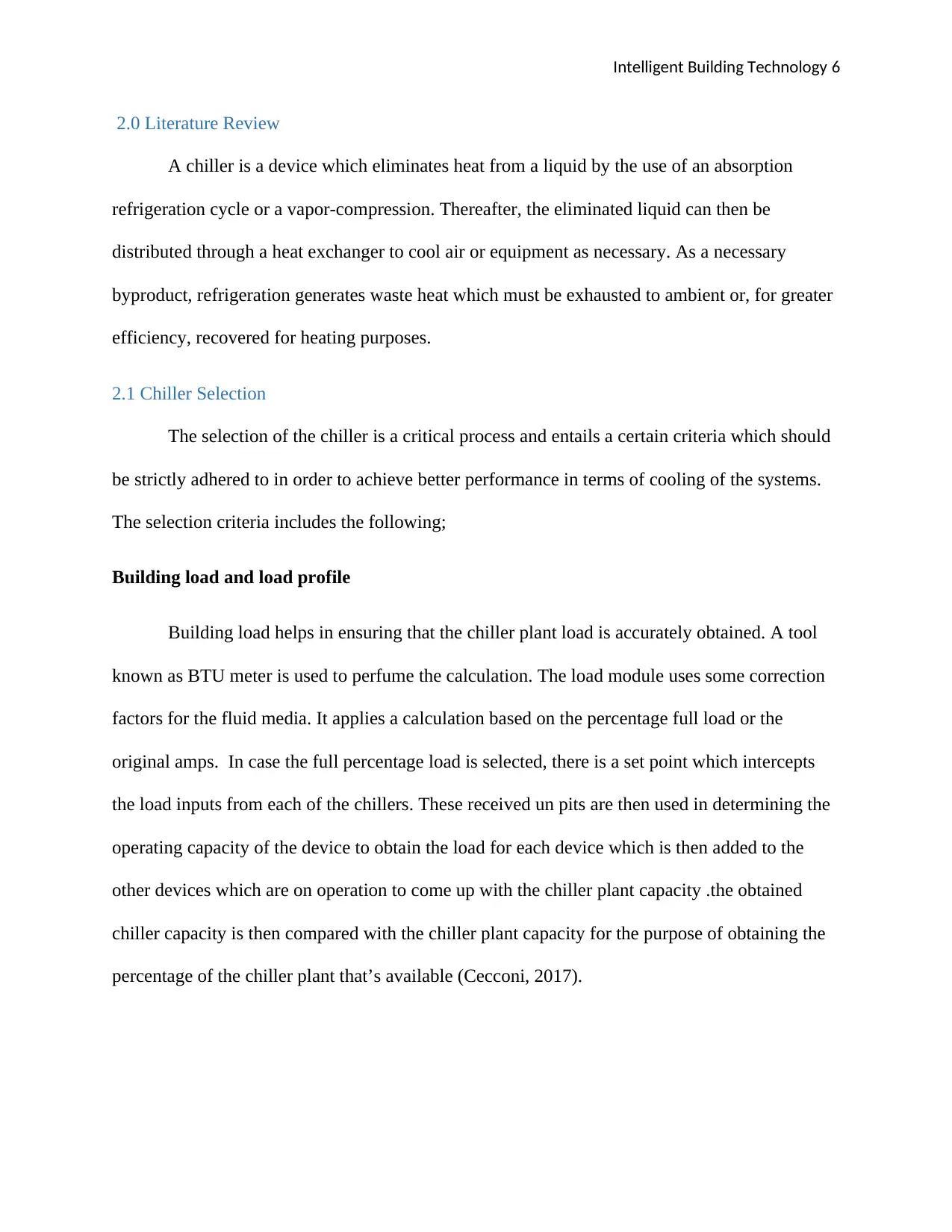
Intelligent Building Technology 6
2.0 Literature Review
A chiller is a device which eliminates heat from a liquid by the use of an absorption
refrigeration cycle or a vapor-compression. Thereafter, the eliminated liquid can then be
distributed through a heat exchanger to cool air or equipment as necessary. As a necessary
byproduct, refrigeration generates waste heat which must be exhausted to ambient or, for greater
efficiency, recovered for heating purposes.
2.1 Chiller Selection
The selection of the chiller is a critical process and entails a certain criteria which should
be strictly adhered to in order to achieve better performance in terms of cooling of the systems.
The selection criteria includes the following;
Building load and load profile
Building load helps in ensuring that the chiller plant load is accurately obtained. A tool
known as BTU meter is used to perfume the calculation. The load module uses some correction
factors for the fluid media. It applies a calculation based on the percentage full load or the
original amps. In case the full percentage load is selected, there is a set point which intercepts
the load inputs from each of the chillers. These received un pits are then used in determining the
operating capacity of the device to obtain the load for each device which is then added to the
other devices which are on operation to come up with the chiller plant capacity .the obtained
chiller capacity is then compared with the chiller plant capacity for the purpose of obtaining the
percentage of the chiller plant that’s available (Cecconi, 2017).
2.0 Literature Review
A chiller is a device which eliminates heat from a liquid by the use of an absorption
refrigeration cycle or a vapor-compression. Thereafter, the eliminated liquid can then be
distributed through a heat exchanger to cool air or equipment as necessary. As a necessary
byproduct, refrigeration generates waste heat which must be exhausted to ambient or, for greater
efficiency, recovered for heating purposes.
2.1 Chiller Selection
The selection of the chiller is a critical process and entails a certain criteria which should
be strictly adhered to in order to achieve better performance in terms of cooling of the systems.
The selection criteria includes the following;
Building load and load profile
Building load helps in ensuring that the chiller plant load is accurately obtained. A tool
known as BTU meter is used to perfume the calculation. The load module uses some correction
factors for the fluid media. It applies a calculation based on the percentage full load or the
original amps. In case the full percentage load is selected, there is a set point which intercepts
the load inputs from each of the chillers. These received un pits are then used in determining the
operating capacity of the device to obtain the load for each device which is then added to the
other devices which are on operation to come up with the chiller plant capacity .the obtained
chiller capacity is then compared with the chiller plant capacity for the purpose of obtaining the
percentage of the chiller plant that’s available (Cecconi, 2017).
⊘ This is a preview!⊘
Do you want full access?
Subscribe today to unlock all pages.

Trusted by 1+ million students worldwide
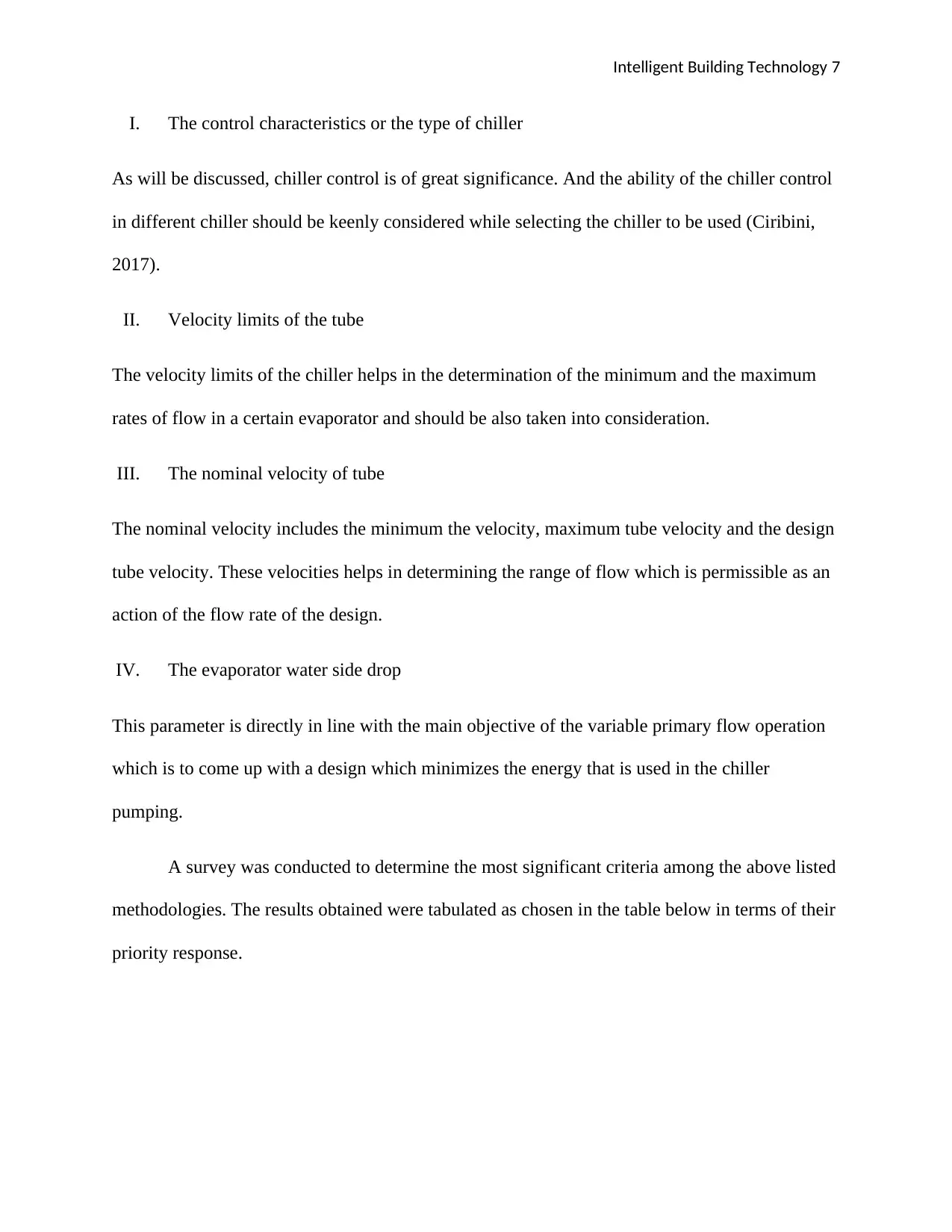
Intelligent Building Technology 7
I. The control characteristics or the type of chiller
As will be discussed, chiller control is of great significance. And the ability of the chiller control
in different chiller should be keenly considered while selecting the chiller to be used (Ciribini,
2017).
II. Velocity limits of the tube
The velocity limits of the chiller helps in the determination of the minimum and the maximum
rates of flow in a certain evaporator and should be also taken into consideration.
III. The nominal velocity of tube
The nominal velocity includes the minimum the velocity, maximum tube velocity and the design
tube velocity. These velocities helps in determining the range of flow which is permissible as an
action of the flow rate of the design.
IV. The evaporator water side drop
This parameter is directly in line with the main objective of the variable primary flow operation
which is to come up with a design which minimizes the energy that is used in the chiller
pumping.
A survey was conducted to determine the most significant criteria among the above listed
methodologies. The results obtained were tabulated as chosen in the table below in terms of their
priority response.
I. The control characteristics or the type of chiller
As will be discussed, chiller control is of great significance. And the ability of the chiller control
in different chiller should be keenly considered while selecting the chiller to be used (Ciribini,
2017).
II. Velocity limits of the tube
The velocity limits of the chiller helps in the determination of the minimum and the maximum
rates of flow in a certain evaporator and should be also taken into consideration.
III. The nominal velocity of tube
The nominal velocity includes the minimum the velocity, maximum tube velocity and the design
tube velocity. These velocities helps in determining the range of flow which is permissible as an
action of the flow rate of the design.
IV. The evaporator water side drop
This parameter is directly in line with the main objective of the variable primary flow operation
which is to come up with a design which minimizes the energy that is used in the chiller
pumping.
A survey was conducted to determine the most significant criteria among the above listed
methodologies. The results obtained were tabulated as chosen in the table below in terms of their
priority response.
Paraphrase This Document
Need a fresh take? Get an instant paraphrase of this document with our AI Paraphraser
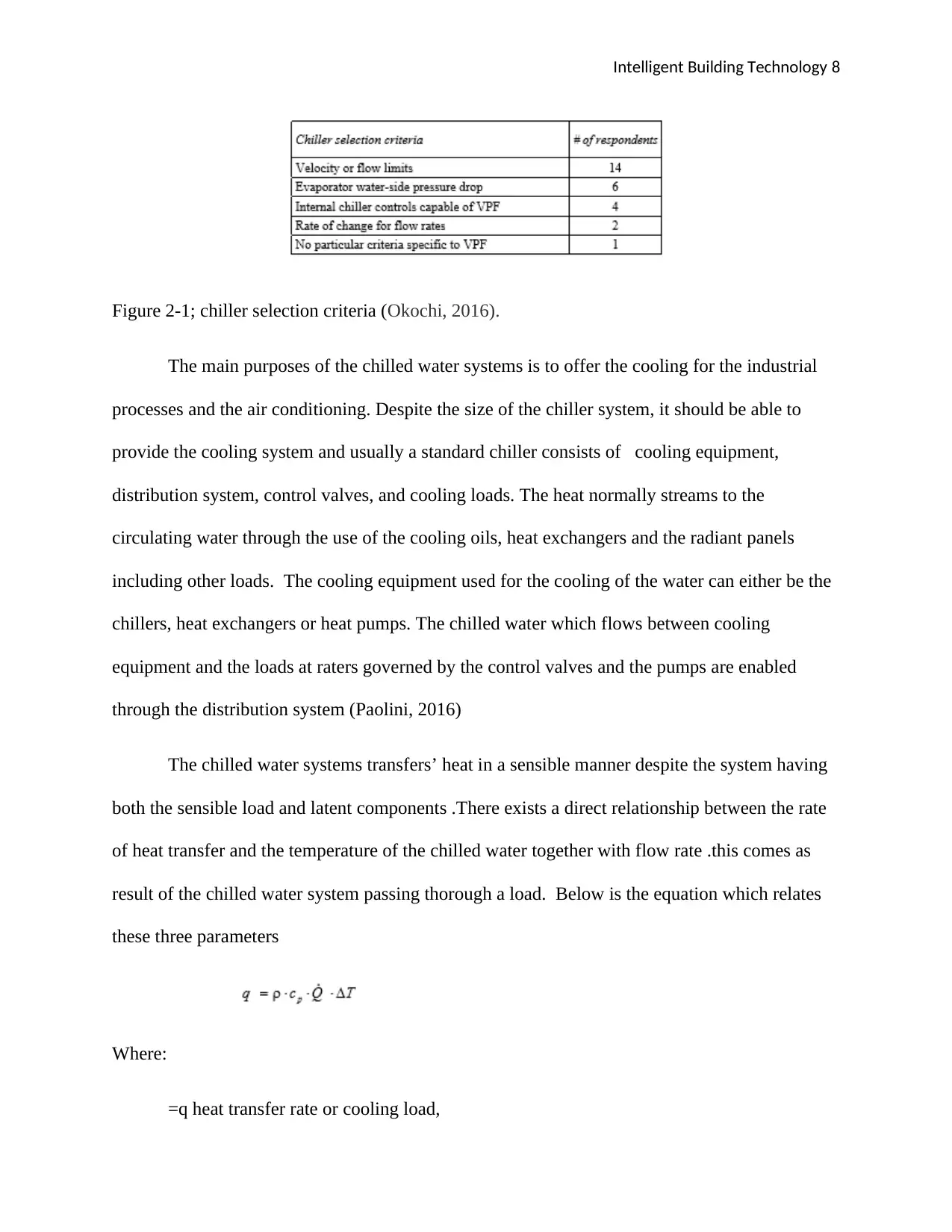
Intelligent Building Technology 8
Figure 2-1; chiller selection criteria (Okochi, 2016).
The main purposes of the chilled water systems is to offer the cooling for the industrial
processes and the air conditioning. Despite the size of the chiller system, it should be able to
provide the cooling system and usually a standard chiller consists of cooling equipment,
distribution system, control valves, and cooling loads. The heat normally streams to the
circulating water through the use of the cooling oils, heat exchangers and the radiant panels
including other loads. The cooling equipment used for the cooling of the water can either be the
chillers, heat exchangers or heat pumps. The chilled water which flows between cooling
equipment and the loads at raters governed by the control valves and the pumps are enabled
through the distribution system (Paolini, 2016)
The chilled water systems transfers’ heat in a sensible manner despite the system having
both the sensible load and latent components .There exists a direct relationship between the rate
of heat transfer and the temperature of the chilled water together with flow rate .this comes as
result of the chilled water system passing thorough a load. Below is the equation which relates
these three parameters
Where:
=q heat transfer rate or cooling load,
Figure 2-1; chiller selection criteria (Okochi, 2016).
The main purposes of the chilled water systems is to offer the cooling for the industrial
processes and the air conditioning. Despite the size of the chiller system, it should be able to
provide the cooling system and usually a standard chiller consists of cooling equipment,
distribution system, control valves, and cooling loads. The heat normally streams to the
circulating water through the use of the cooling oils, heat exchangers and the radiant panels
including other loads. The cooling equipment used for the cooling of the water can either be the
chillers, heat exchangers or heat pumps. The chilled water which flows between cooling
equipment and the loads at raters governed by the control valves and the pumps are enabled
through the distribution system (Paolini, 2016)
The chilled water systems transfers’ heat in a sensible manner despite the system having
both the sensible load and latent components .There exists a direct relationship between the rate
of heat transfer and the temperature of the chilled water together with flow rate .this comes as
result of the chilled water system passing thorough a load. Below is the equation which relates
these three parameters
Where:
=q heat transfer rate or cooling load,
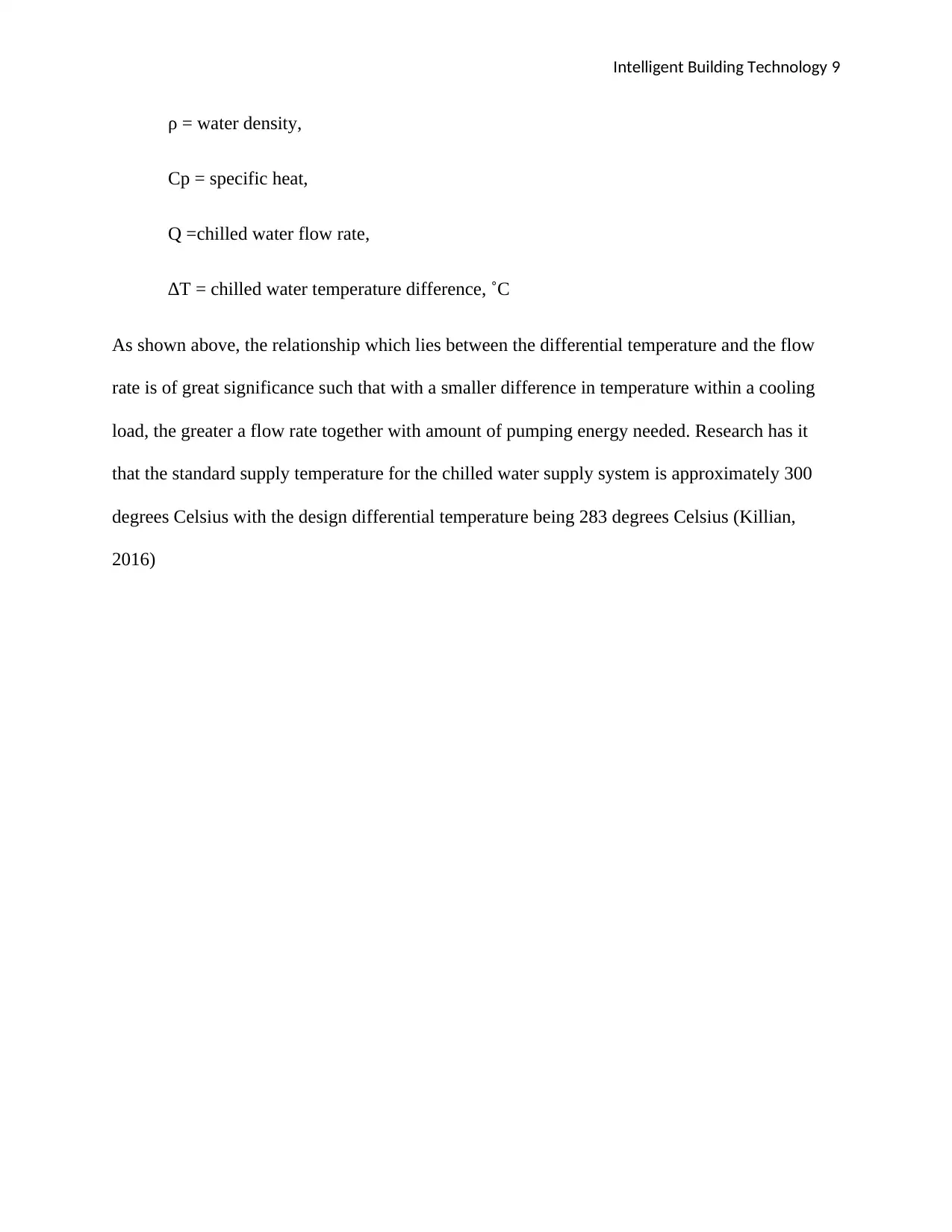
Intelligent Building Technology 9
ρ = water density,
Cp = specific heat,
Q =chilled water flow rate,
∆T = chilled water temperature difference, ˚C
As shown above, the relationship which lies between the differential temperature and the flow
rate is of great significance such that with a smaller difference in temperature within a cooling
load, the greater a flow rate together with amount of pumping energy needed. Research has it
that the standard supply temperature for the chilled water supply system is approximately 300
degrees Celsius with the design differential temperature being 283 degrees Celsius (Killian,
2016)
ρ = water density,
Cp = specific heat,
Q =chilled water flow rate,
∆T = chilled water temperature difference, ˚C
As shown above, the relationship which lies between the differential temperature and the flow
rate is of great significance such that with a smaller difference in temperature within a cooling
load, the greater a flow rate together with amount of pumping energy needed. Research has it
that the standard supply temperature for the chilled water supply system is approximately 300
degrees Celsius with the design differential temperature being 283 degrees Celsius (Killian,
2016)
⊘ This is a preview!⊘
Do you want full access?
Subscribe today to unlock all pages.

Trusted by 1+ million students worldwide
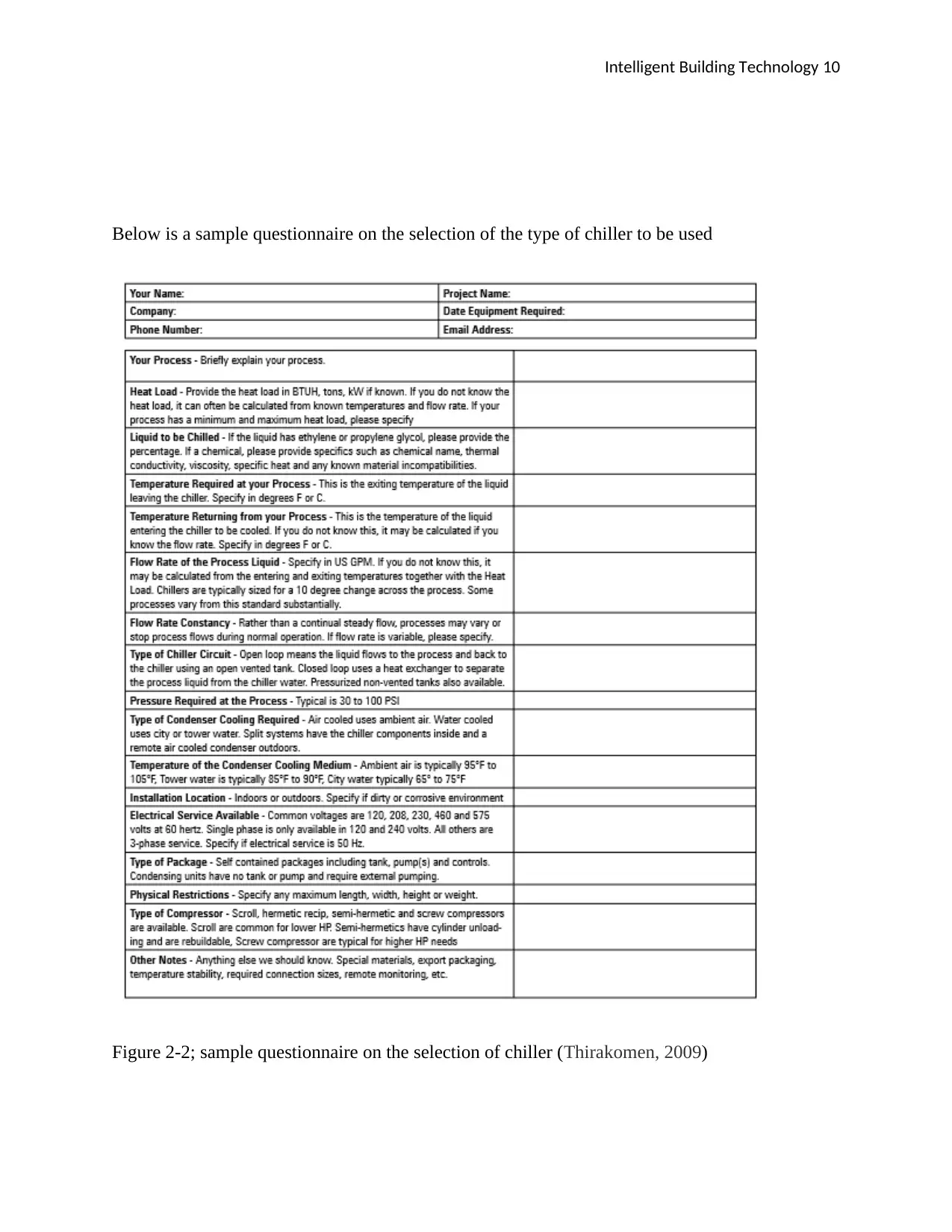
Intelligent Building Technology 10
Below is a sample questionnaire on the selection of the type of chiller to be used
Figure 2-2; sample questionnaire on the selection of chiller (Thirakomen, 2009)
Below is a sample questionnaire on the selection of the type of chiller to be used
Figure 2-2; sample questionnaire on the selection of chiller (Thirakomen, 2009)
Paraphrase This Document
Need a fresh take? Get an instant paraphrase of this document with our AI Paraphraser
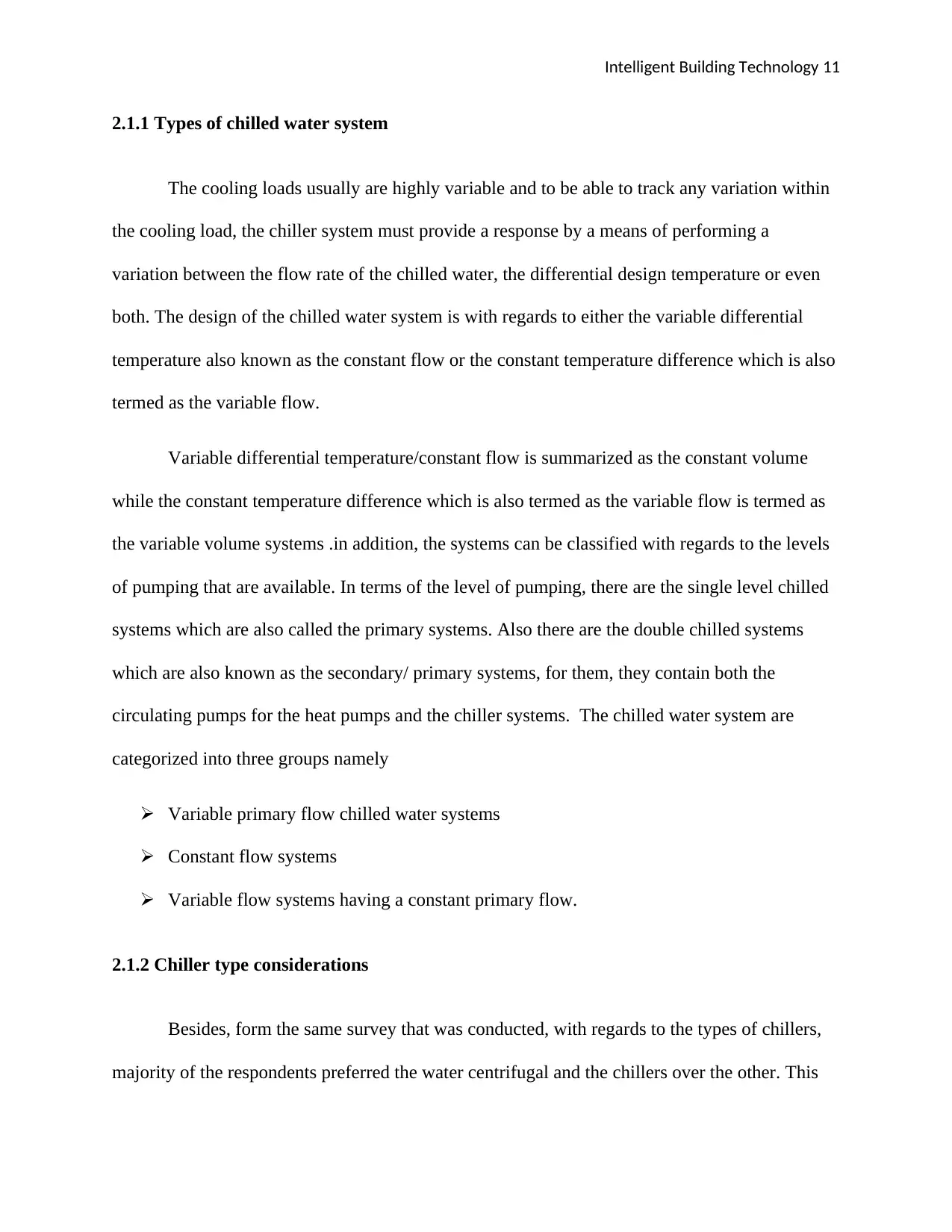
Intelligent Building Technology 11
2.1.1 Types of chilled water system
The cooling loads usually are highly variable and to be able to track any variation within
the cooling load, the chiller system must provide a response by a means of performing a
variation between the flow rate of the chilled water, the differential design temperature or even
both. The design of the chilled water system is with regards to either the variable differential
temperature also known as the constant flow or the constant temperature difference which is also
termed as the variable flow.
Variable differential temperature/constant flow is summarized as the constant volume
while the constant temperature difference which is also termed as the variable flow is termed as
the variable volume systems .in addition, the systems can be classified with regards to the levels
of pumping that are available. In terms of the level of pumping, there are the single level chilled
systems which are also called the primary systems. Also there are the double chilled systems
which are also known as the secondary/ primary systems, for them, they contain both the
circulating pumps for the heat pumps and the chiller systems. The chilled water system are
categorized into three groups namely
Variable primary flow chilled water systems
Constant flow systems
Variable flow systems having a constant primary flow.
2.1.2 Chiller type considerations
Besides, form the same survey that was conducted, with regards to the types of chillers,
majority of the respondents preferred the water centrifugal and the chillers over the other. This
2.1.1 Types of chilled water system
The cooling loads usually are highly variable and to be able to track any variation within
the cooling load, the chiller system must provide a response by a means of performing a
variation between the flow rate of the chilled water, the differential design temperature or even
both. The design of the chilled water system is with regards to either the variable differential
temperature also known as the constant flow or the constant temperature difference which is also
termed as the variable flow.
Variable differential temperature/constant flow is summarized as the constant volume
while the constant temperature difference which is also termed as the variable flow is termed as
the variable volume systems .in addition, the systems can be classified with regards to the levels
of pumping that are available. In terms of the level of pumping, there are the single level chilled
systems which are also called the primary systems. Also there are the double chilled systems
which are also known as the secondary/ primary systems, for them, they contain both the
circulating pumps for the heat pumps and the chiller systems. The chilled water system are
categorized into three groups namely
Variable primary flow chilled water systems
Constant flow systems
Variable flow systems having a constant primary flow.
2.1.2 Chiller type considerations
Besides, form the same survey that was conducted, with regards to the types of chillers,
majority of the respondents preferred the water centrifugal and the chillers over the other. This
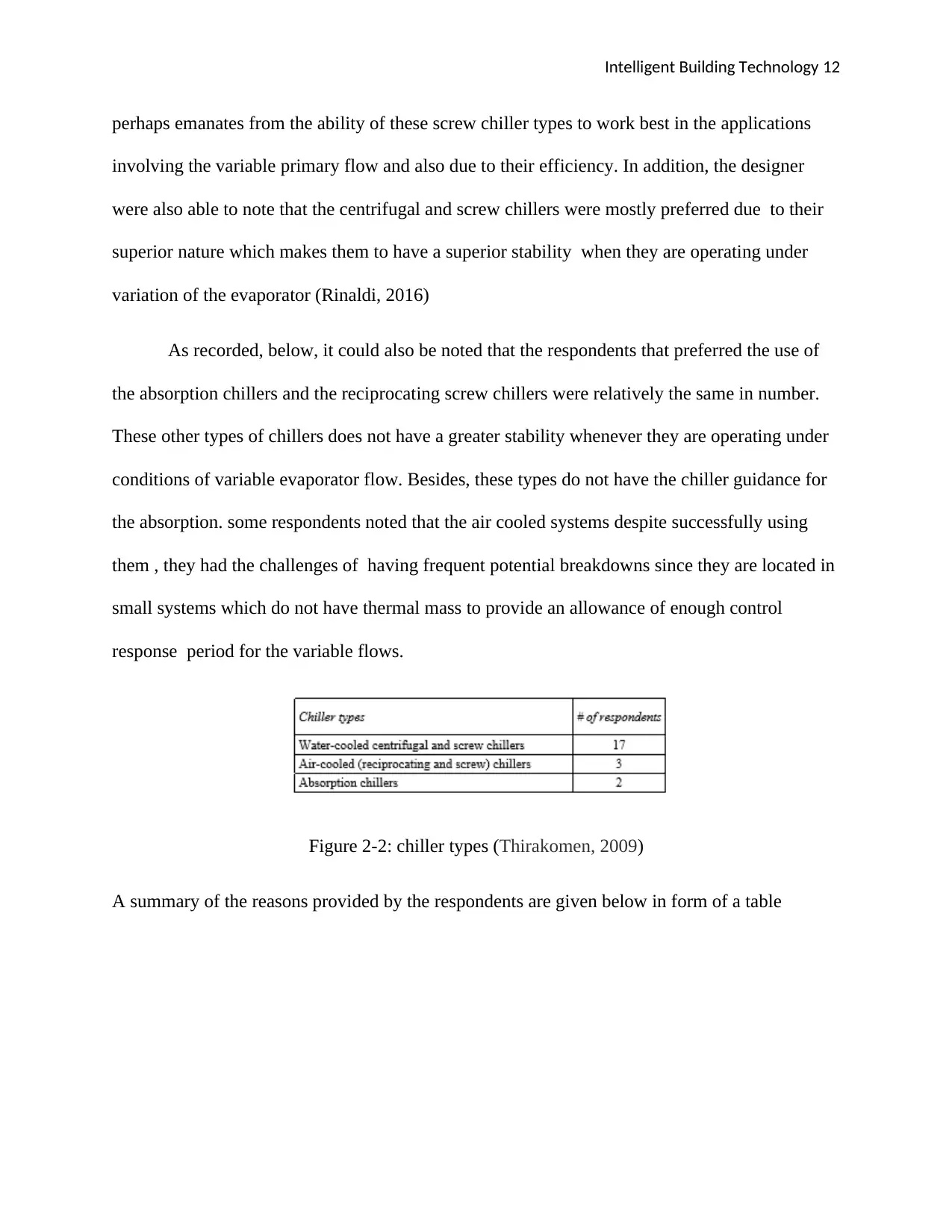
Intelligent Building Technology 12
perhaps emanates from the ability of these screw chiller types to work best in the applications
involving the variable primary flow and also due to their efficiency. In addition, the designer
were also able to note that the centrifugal and screw chillers were mostly preferred due to their
superior nature which makes them to have a superior stability when they are operating under
variation of the evaporator (Rinaldi, 2016)
As recorded, below, it could also be noted that the respondents that preferred the use of
the absorption chillers and the reciprocating screw chillers were relatively the same in number.
These other types of chillers does not have a greater stability whenever they are operating under
conditions of variable evaporator flow. Besides, these types do not have the chiller guidance for
the absorption. some respondents noted that the air cooled systems despite successfully using
them , they had the challenges of having frequent potential breakdowns since they are located in
small systems which do not have thermal mass to provide an allowance of enough control
response period for the variable flows.
Figure 2-2: chiller types (Thirakomen, 2009)
A summary of the reasons provided by the respondents are given below in form of a table
perhaps emanates from the ability of these screw chiller types to work best in the applications
involving the variable primary flow and also due to their efficiency. In addition, the designer
were also able to note that the centrifugal and screw chillers were mostly preferred due to their
superior nature which makes them to have a superior stability when they are operating under
variation of the evaporator (Rinaldi, 2016)
As recorded, below, it could also be noted that the respondents that preferred the use of
the absorption chillers and the reciprocating screw chillers were relatively the same in number.
These other types of chillers does not have a greater stability whenever they are operating under
conditions of variable evaporator flow. Besides, these types do not have the chiller guidance for
the absorption. some respondents noted that the air cooled systems despite successfully using
them , they had the challenges of having frequent potential breakdowns since they are located in
small systems which do not have thermal mass to provide an allowance of enough control
response period for the variable flows.
Figure 2-2: chiller types (Thirakomen, 2009)
A summary of the reasons provided by the respondents are given below in form of a table
⊘ This is a preview!⊘
Do you want full access?
Subscribe today to unlock all pages.

Trusted by 1+ million students worldwide
1 out of 32
Your All-in-One AI-Powered Toolkit for Academic Success.
+13062052269
info@desklib.com
Available 24*7 on WhatsApp / Email
![[object Object]](/_next/static/media/star-bottom.7253800d.svg)
Unlock your academic potential
Copyright © 2020–2025 A2Z Services. All Rights Reserved. Developed and managed by ZUCOL.